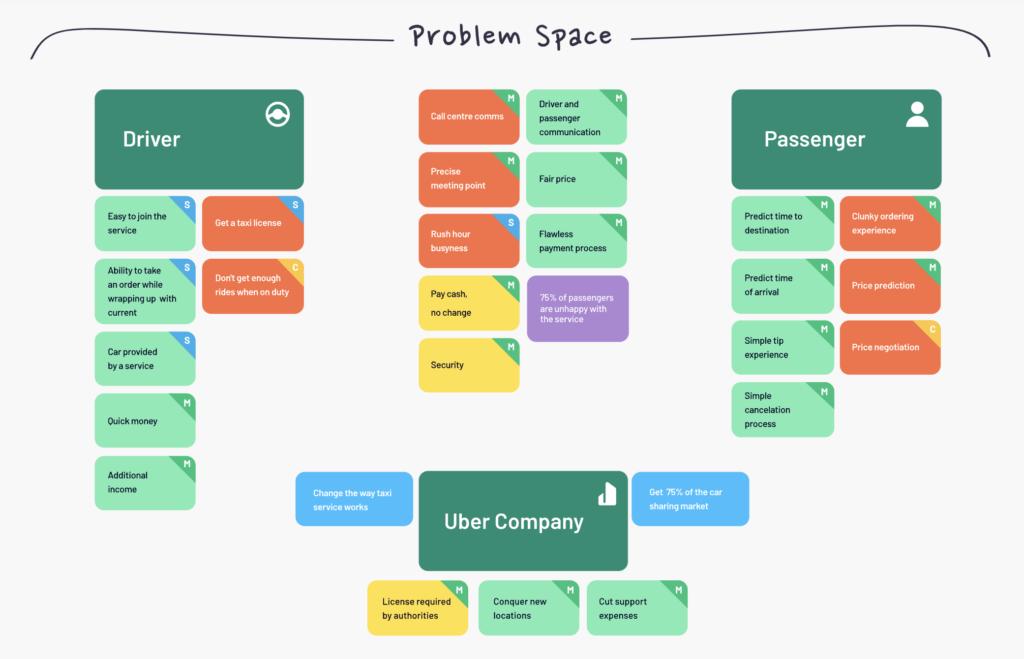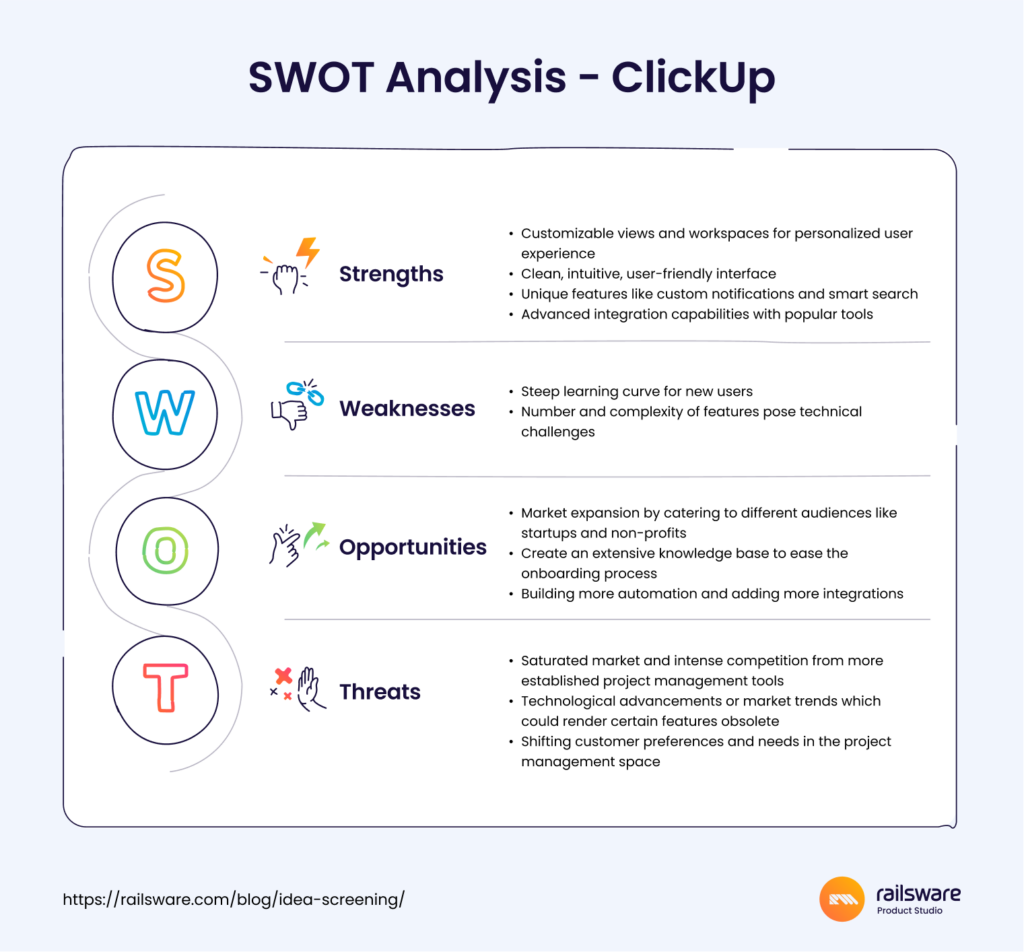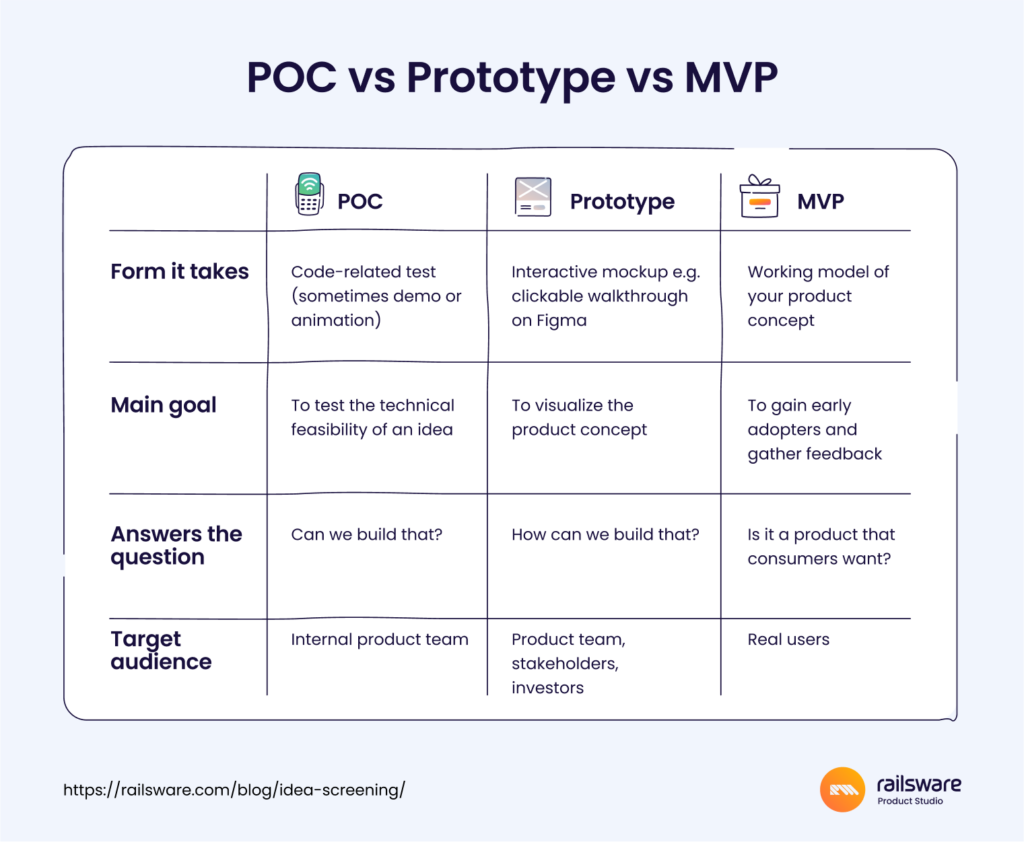
What is idea screening?
Idea screening is the process of filtering and selecting the most promising product concepts from a pool of ideas. It is one of the first steps in the new product development process – a six-stage blueprint for transforming new concepts into viable products.
Startups or product teams typically use frameworks and research to screen new product ideas. They consider factors like market demand, customer needs, technical feasibility, and available resources when deciding which idea(s) to move forward with.
Why should you always screen ideas?
Although far less talked about than prototyping or beta releases, idea screening is a crucial stage within the new product development process. It acts as the gatekeeper, ensuring only ideas with a high probability of success are advanced for testing. As a result, startups can focus their efforts on building the right product from the beginning, and ultimately, avoid failure.
Essentially, idea screening saves time and money in the long run. Even if you do have the manpower or funds to create quick POCs/prototypes and test them among the team, it’s still a waste of limited company resources.
Screening allows founders and product teams to identify the ideas worthy of testing. At Railsware, it helps us:
- Estimate the feasibility of an idea based on research
- Think about the practical implications of an idea: do consumers want it, and is there a chance of finding a product-market fit?
- Check if an idea aligns with our current goals or product vision
- Mitigate the risk of a new project or startup failure
And ultimately, allocate resources to the right projects and experiments.
As you can see, it’s less about separating the good ideas from the bad ones, and more about assessing the potential value of each solution. Just because an idea is clever or unique, doesn’t mean it’s viable.
Idea screening vs idea generation
As we mentioned earlier, ideation or product discovery is the first stage of the new product development process. At Railsware, we split that stage into two parts: idea generation and idea screening.
Idea generation is a creative exercise. The team identifies a problem, investigates its context, specifies the benefits, risks, or issues associated with the problem, and generates potential solutions based on that information.
Idea screening is a critical thinking exercise. The team analyzes all the hypothetical solutions produced during an idea-generation session, conducts in-depth customer/market research, and chooses the best option(s) to move forward with.
Although they are different activities, idea generation and idea screening go hand-in-hand within our BRIDGeS framework (more on that later).
It’s also important to clarify that idea screening is not the same as idea testing or idea validation. As we said, screening happens during the discovery stage of new product development. It’s mostly theoretical (evaluating ideas and estimating their potential). Meanwhile, concept testing happens during the validation stage and is more hands-on (e.g. creating and experimenting with a prototype).
Key elements of idea screening process
As we explain the process and discuss examples, we’ll focus mainly on idea screening in a new product development context. Here we’re talking about the product idea, although many of the techniques and processes we mention can also be used when screening ideas for new features, side projects, etc.
Evaluating ideas against set criteria
Before moving ahead with any new product idea, always ask the following questions: Does this idea solve a real problem? Does it address a burning need of our target customer?
You don’t need to have the answer right away; that’s what testing’s for. But your customers’ needs should be at the forefront of your mind as you assess the strength of your idea.
With that said, here are some other questions the screening process should answer:
- Feasibility: From a technical standpoint, is the idea feasible? You can explore this point further with POC testing, but with some ideas, it’ll be more obvious e.g. how about we create the next TikTok?
- Current market: What’s the competition like? Is the target market already saturated?
- Goal alignment: Does this idea align with our strategic goals and product vision?
- Estimated impact: What kind of impact might our idea have on stakeholders/market/consumers in general?
- Scaleability: If we move forward with this idea, does it have growth potential?
- Resources: Do we have the available development/design/marketing resources to make this idea a reality? And maintain it after implementation?
Note: This step can be incorporated into an ideation session, where the team is already exploring the various strengths and weaknesses of the concept and the needs of customers. We’ll recommend some suitable frameworks later on.
Conduct in-depth research
Research is essential to the screening process. But to avoid confirmation bias, it’s important to do more than just a rudimentary scan on Google for studies that back up your idea. Conducting both qualitative and quantitative research is key.
Qualitative research
The earlier you start talking to potential customers about your idea, the sooner you’ll know if it’s worth pursuing.
Run surveys. Create a video survey to gather opinions on your product idea from your target audience. Promote it on platforms where they are active (networking communities, LinkedIn, etc) and collect the findings in a spreadsheet, so you can properly analyze responses and spot consensus. Ask detailed questions about customer habits too, not just about the product idea itself e.g. ‘What is your main frustration with X problem?’ as well as ‘How do you think the current solution could be improved?’
Talk directly to potential customers. Schedule interviews with people who could potentially benefit from your idea. Ask them open-ended questions about their pains and preferences, and what they think about your proposed solution. Again, synthesize your findings in a spreadsheet so you can identify common concerns or suggestions. Then, assess how your idea fits into that. So far, does it seem like a problem worth solving? Read our comprehensive guide to customer development to learn more about how to conduct unbiased interviews.
Quantitative research
Test product hypotheses. Running time-boxed A/B tests on smaller assumptions can be a good way to figure out if an idea is worth pursuing further, or even structure your idea in a way that better responds to customer needs. For best results, follow the steps in our full guide to product hypothesis testing.
Market research. Gartner, Forrester, and McKinsey and Co. are decent sources for uncovering market trends and understanding customer behavior and attitudes.
Competitor research. You can also perform competitor research at this stage to understand how your proposed solution compares to market alternatives. What are your competitors doing better? Does your concept have a unique selling point? Analyze competitors’ product characteristics, messaging, sales tactics, etc.
Bridges framework for idea screening
At Railsware, we spent years searching for an idea generation and screening framework that would allow us to investigate an idea from multiple perspectives, explore more than one subject (product stakeholder) at a time, and get everyone on the same page vision-wise.
In the end, we didn’t find it, so we decided to develop our own: the BRIDGeS framework (inspired by Pivotal Lab’s Inception). BRIDGeS is a multi-context analysis tool for ideation and decision-making. To get familiar with the process, check out the step-by-step guide and how to prepare.
BRIDGeS stands for Benefits, Risks, Issues, Domain Knowledge, Goals, and Solutions. Here’s a quick explanation of each problem descriptor, to understand how they allow us to investigate a product idea.
Benefits describe the value a Subject can get from a potential solution.
Risks refer to the challenges a Subject might face in the future.
Issues describe the existing problems of the Subject.
Domain Knowledge is any additional knowledge (e.g. market research) we should keep in mind when discussing the problem.
Goals are the results we hope to get from the future solution.
Earlier, we created a BRIDGeS Uber case study where we imagine Uber as a new product idea. We identified 3 subjects: Driver, Passenger, and Uber Company. Here’s what the idea looks like when broken down.

Bearing that example in mind, here are some of the main benefits of BRIDGeS for idea screening.
- Focuses on the needs and pains of the target customer, rather than the strengths or weaknesses of the concept itself.
- Prioritization with MoSCoW lets us understand which benefits, risks, or issues associated with the idea are most/least important.
- We can explore more than one subject at a time, which allows us to develop more well-rounded solutions.
Essentially, BRIDGeS enables us to examine a product concept from all angles – a critical element of idea screening in general. By following the steps from the Problem Space to the Solution Space, we can create a well-rounded, fully-vetted solution ready for testing (and even get a list of epics and tasks that can be transformed into a product roadmap).
Other idea screening examples
SWOT Analysis
SWOT – which stands for Strengths, Weaknesses, Opportunities, Threats – is easily one of the most popular idea-screening techniques for startups. Like BRIDGeS, it’s a simple yet effective tool for examining ideas and strategies.
However, it has some significant drawbacks, which we’ll point out shortly. First, a brief explanation of each term.
Strengths: Internal advantages and resources that give the future product a good chance of success.
Weaknesses: Internal factors that put your future product at a disadvantage compared to competitors.
Opportunities: External trends or events that may benefit your product.
Threats: External challenges that may hinder the future product’s success.
Let’s explore an example of a SWOT analysis applied to the project management tool ClickUp (from the perspective of ClickUp compared to its competitors as a new product idea).

Benefits of SWOT for idea screening
- Simple, compact, and versatile framework.
- When evaluating multiple ideas or competitor products, it’s easy to compare the strengths and weaknesses of each.
- Allows you to explore both the internal and external factors that may affect your future product.
Limitations of SWOT for idea screening
- Difficult to investigate the details and context of an idea, due to simplicity of the tool.
- No direct path to possible solutions or a solid conclusion.
- No built-in method of prioritization.
PESTEL analysis
PESTEL is another well-known framework for assessing the viability of a product idea. It’s an extended version of the PEST analysis and an acronym for Political, Economic, Social, Technological, Environmental, and Legal factors.
Unlike BRIDGeS or SWOT, PESTEL only focuses on the external factors that can impact the success of a future product. This is one of its most glaring limitations. However, PESTEL allows you to dive deeper into the threats and opportunities relevant to a product idea.
Like many other strategic planning tools, the process simply involves listing the issues associated with each factor. Let’s break down each term.
Political: Leadership, government regulations, foreign trade policies, political trends, etc. that could impact the introduction or marketing of a new product.
Economic: Considers issues such as market demand, economic growth, inflation, and pricing dynamics to check the financial feasibility of a new product.
Sociocultural: Consumer preferences, societal trends, or cultural shifts that could impact new product adoption.
Technological: Any technological advancements that could either accelerate the product’s growth or render the solution obsolete.
Environmental: Concerns relating to sustainable product development, carbon footprint, etc.Legal: Any industry regulations or consumer laws that may affect the production, distribution or adoption of a new product.
Benefits of PESTEL for idea screening
- Allows you to thoroughly examine the various external forces that can damage or boost a future product’s success.
- Provides valuable insights to incorporate into a future product strategy or roadmap.
Limitations of PESTEL for idea screening
- Exclusive focus on external factors makes it impossible to assess the whole picture.
- No opportunity within the framework to explore solutions to identified threats or weaknesses.
- The complexity and sheer variety of factors make prioritization challenging.
What comes after idea screening
As you might have already guessed, testing is the next step after idea screening.
But in a new product development context, what does that actually look like? The truth is, it’s different for every startup, depending on the complexity and uniqueness of the product idea.
Once you’ve screened ideas and selected one to proceed with, there are generally three main options for the next step.
- Create a proof of concept (POC)
- Design a prototype
- Build a minimum viable product (MVP)
Here’s a brief rundown of each concept’s characteristics and the difference between POC, prototype, and MVP.

Note: In our experience, proof of concept is only necessary when you have doubts about the technical feasibility of the future product.
At Railsware, we often start with a clickable, no-code prototype to visualize the proposed solution. It allows us to map the user flow, simulate potential features, experiment with the design, and ultimately decide if the idea has substance. We don’t spend a lot of time on this step, as few prototypes ever make it past the testing phase.
However, if a prototype is successful, we proceed to the next stages of testing. This time, we’re aiming to create and test a semi-functional product. After much behind-the-scenes work – such as choosing the tech stack, planning the system architecture, and designing a skeleton – we move on to:
- Pilot testing. Refining the overall solution with customer feedback, before it’s given a real shape.
- Alpha/beta release. Attracting early adopters with a limited but well-designed version of the initial product. Using their feedback to iterate on the solution.
These stages aren’t mandatory but we wouldn’t recommend skipping them, particularly if you have some time and resources to spare. It will give you extra confidence in your solution prior to entering the next testing phase – MVP development and release.
At this point, the goal is to get feedback on the solution from real users. The MVP is a functional, barebones version of your product – it’s your idea in action. Although chances are, after multiple iterations, it probably won’t bear much resemblance to the original screened idea. And that’s ok. At this stage of testing, it’s more important than ever to listen to customers and learn if your solution is worth developing further.
We won’t go into the mechanics of MVP release here, but we recommend reading our post on common MVP misconceptions for more insight. As for the next steps, see our guide on What to do with your startup after an MVP.
Wrapping Up
Idea screening helps startups pick the most promising product concepts for testing and development. As we saw, there’s more to it than just listing the pros and cons of a potential solution. To understand the value and viability of a future product, we have to dive deep into its context, investigate internal and external influences, and most importantly, check how well it responds to market needs.
Interested in working with our team of experts on your product concept? Have a look at our product development services to see if we can help with ideation, prototyping, and more.